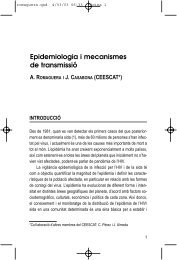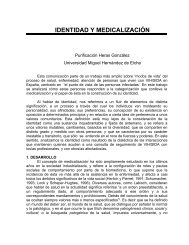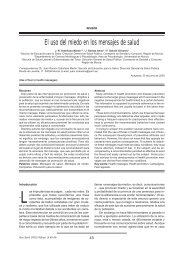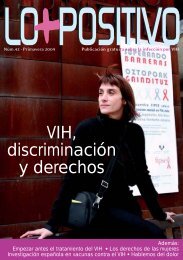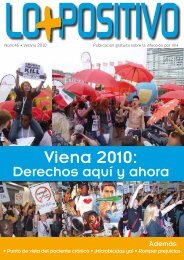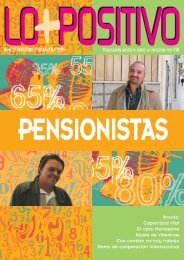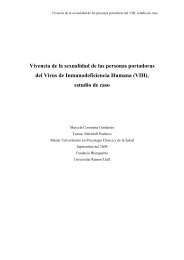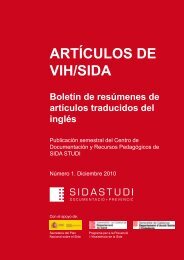Report - Sida Studi
Report - Sida Studi
Report - Sida Studi
Create successful ePaper yourself
Turn your PDF publications into a flip-book with our unique Google optimized e-Paper software.
Friday 30 September 2005: New Trends<br />
5 Plenary session 1: Youth & Religious Leaders<br />
tity attached to human life in Islam;<br />
• The challenge of squaring their position with the<br />
assumption of human dignity;<br />
• The challenge of squaring their position with the need to<br />
provide information.<br />
Mr Segujja noted the enormous potential of mosques<br />
as venues for education and the dissemination of information<br />
to young people and concluded with an appeal<br />
to the meeting that each participant remember their<br />
humanity, that they are not angels, but people characterised<br />
by shortcomings and to remember the Islamic law<br />
that states that necessity knows no rules and that when<br />
all our efforts to solve a problem have failed, we must<br />
look at some other unconventional ways solutions.<br />
5.22 Working with Roma populations (young & older generations),<br />
Mr Jozsef Bonifaz Solymosy, Hungary<br />
Mr Solymosy began his presentation by providing the<br />
meeting with some background information on Gypsy<br />
peoples in Hungary. He emphasised their heterogeneity<br />
as a group comprising peoples who speak a number of<br />
languages and have citizenship in a number of countries.<br />
He also noted that despite their legal equality within<br />
Hungary, they are still subject to disproportionate levels<br />
of poverty, social exclusion and racial discrimination.<br />
In connection with this social marginalisation they are<br />
disproportionately affected by HIV/AIDS. He added that<br />
while these generalisations were true when gypsy peoples<br />
were considered en masse, it was important to note that<br />
particular communities within the sub-population were<br />
differentially disadvantaged. For example, the major issue<br />
for one sub-group might be access to housing while for<br />
another it might be access to health care. Mr Solymosy<br />
described religious adherence within gypsy populations<br />
in Hungary as characterised by diversity with some<br />
groups identifying as preponderantly Roman Catholic,<br />
others as Muslim, and yet others with a range of other<br />
faiths. Turning to wider social attitudes towards gypsy<br />
populations within Hungary, Mr Solymosy observed that<br />
there was a tendency for Hungarians to romanticise gypsy<br />
culture and focus on dimensions like their rich folk traditions<br />
rather than attend to their social and health needs.<br />
Mr Solymosy explained that both public policy and<br />
service provision tended to be aimed at addressing higher<br />
level needs and hence effectively discriminated against<br />
people, like gypsies, who experienced more fundamental<br />
needs. He concluded his presentation by briefly outlining<br />
an intervention aimed at gypsy children and young people<br />
with education, support and childcare through the<br />
provision of a summer activity camp. This intervention<br />
was run with and through a Roman Catholic church.<br />
5.3 Short presentations of other panel members<br />
<br />
5.31 An inter-denominational response to HIV/AIDS, Mr<br />
Ravi Chandran: Inter-denominational cleric, Denmark<br />
Mr Ravi Chandran of the International Christian<br />
Community introduced himself as an inter-denominational<br />
religious leader originally from Senegal now living<br />
in Denmark. He began his short presentation by affirming<br />
Mr Segujja’s remarks about the difficulties faced by<br />
all religions in engaging with HIV/AIDS because of problems<br />
with discussing sexuality. He also acknowledged the<br />
existence of counterproductive tensions between faiths<br />
and described himself as working to ameliorate these.<br />
Mr Chandran argued for unity between faith groups on<br />
HIV/AIDS issues forged around a common agreement on<br />
human rights.<br />
5.32 Working with young male sex workers and religion, Mr<br />
Isidro García Nieto, Spain<br />
Mr Isidro García Nieto introduced himself and described<br />
the main activities of his project – street outreach, peerto-peer<br />
working and some limited workshop activities<br />
with young male sex workers aged generally between<br />
18 and 19 and mainly from Brazil, Eastern Europe and<br />
Morocco. He emphasised the importance of acknowledging<br />
the cultural and religious background of the client<br />
group with which he works, particularly in relation to the<br />
way that it shapes their conceptualisations of homosexuality<br />
and gender. For example, some male sex workers do<br />
not see themselves as gay and therefore believe they are<br />
not at risk of HIV/AIDS.<br />
5.33 Working with young Roma people, Ms Katarína<br />
Jiresová, Slovakia<br />
Ms Katarína Jiresová very briefly described the project in<br />
which she is involved which works primarily with groups<br />
of young people vulnerable to or engaged in injecting<br />
drug use or sex work. She noted that because of their<br />
social exclusion Roma people are over-represented in this<br />
group. Noting the short time remaining in the session she<br />
declined to give more detail and suggested instead people<br />
take the opportunity to ask her questions when the plenary<br />
was opened for discussion from the floor.<br />
5.4 Panel discussion<br />
The presentations were followed by a short period of<br />
discussion directed by questions from the floor. In<br />
response to a question about whether religious leaders<br />
were involved in the work around PWHA by the World<br />
Council of Churches, Mr Ravi Chandran reported that he<br />
personally was working with colleagues towards this level<br />
of collaboration and strongly supported similar moves<br />
among other faith groups.<br />
In response to a observation that differences between<br />
faith groups seemed to be an obstacle to collaborative<br />
work between different faith groups, Mr Chandran added<br />
that it was indeed the case that up to now attempts at<br />
inter-faith activity had been characterised by strive rather<br />
than agreement. The difficulty and its resolution lie in<br />
identifying and reaching agreement on basic principles.<br />
Mr Segujja concurred in relation to this point about basic<br />
principles which might be agreed by all faiths. He said<br />
13



